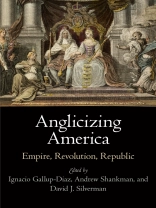The thirteen mainland colonies of early America were arguably never more British than on the eve of their War of Independence from Britain. Though home to settlers of diverse national and cultural backgrounds, colonial America gradually became more like Britain in its political and judicial systems, material culture, economies, religious systems, and engagements with the empire. At the same time and by the same process, these politically distinct and geographically distant colonies forged a shared cultural identity—one that would bind them together as a nation during the Revolution.
Anglicizing America revisits the theory of Anglicization, considering its application to the history of the Atlantic world, from Britain to the Caribbean to the western wildernesses, at key moments before, during, and after the American Revolution. Ten essays by senior historians trace the complex processes by which global forces, local economies, and individual motives interacted to reinforce a more centralized and unified social movement. They examine the ways English ideas about labor influenced plantation slavery, how Great Britain’s imperial aspirations shaped American militarization, the influence of religious tolerance on political unity, and how Americans’ relationship to Great Britain after the war impacted the early republic’s naval and taxation policies. As a whole, Anglicizing America offers a compelling framework for explaining the complex processes at work in the western hemisphere during the age of revolutions.
Contributors : Denver Brunsman, William Howard Carter, Ignacio Gallup-Diaz, Anthony M. Joseph, Simon P. Newman, Geoffrey Plank, Nancy L. Rhoden, Andrew Shankman, David J. Silverman, Jeremy A. Stern.
สารบัญ
Introduction
—Ignacio Gallup-Diaz, Andrew Shankman, and David J. Silverman
PART I. ANGLICIZATION
Chapter 1. England and Colonial America: A Novel Theory of the American Revolution
—John M. Murrin
Chapter 2. A Synthesis Useful and Compelling: Anglicization and the Achievement of John M. Murrin
—Andrew Shankman
PART II. EMPIRE
Chapter 3. ‘In Great Slavery and Bondage’: White Labor and the Development of Plantation Slavery in British America
—Simon P. Newman
Chapter 4. Anglicizing the League: The Writing of Cadwallader Colden’s History of the Five Indian Nations
—William Howard Carter
Chapter 5. A Medieval Response to a Wilderness Need: Anglicizing Warfare in Colonial America
—Geoffrey Plank
PART III. REVOLUTION
Chapter 6. Anglicanism, Dissent, and Toleration in Eighteenth-Century British Colonies
—Nancy L. Rhoden
Chapter 7. Anglicization Against the Empire: Revolutionary Ideas and Identity in Townshend Crisis Massachusetts
—Jeremy A. Stern
PART IV. REPUBLIC
Chapter 8. Racial Walls: Race and the Emergence of American White Nationalism
—David J. Silverman
Chapter 9. De-Anglicization: The Jeffersonian Attack on an American Naval Establishment
—Denver Brunsman
Chapter 10. Anglicization and the American Taxpayer, c. 1763-1815
—Anthony M. Joseph
Conclusion. Anglicization Reconsidered
—Ignacio Gallup-Diaz
Notes
List of Contributors
Index
Acknowledgments
เกี่ยวกับผู้แต่ง
Ignacio Gallup-Diaz is Associate Professor and Chair of the Department of History at Bryn Mawr College. He is author of The Door of the Seas and Key to the Universe: Indian Politics and Imperial Rivalry in the Darien, 1640-1750. Andrew Shankman is Associate Professor of History at Rutgers University and author of Crucible of American Democracy: The Struggle to Fuse Egalitarianism and Capitalism in Jeffersonian Pennsylvania. David J. Silverman is Professor of History at George Washington University. He is author of Red Brethren: The Brothertown and Stockbridge Indians and the Problem of Race in Early America and Faith and Boundaries: Colonists, Christianity, and Community Among the Wampanoag Indians of Martha’s Vineyard, 1600-1871, and coauthor of Ninigret, Sachem of the Niantics and Narragansetts: Diplomacy, War, and the Balance of Power in Seventeenth-Century New England and Indian Country.












